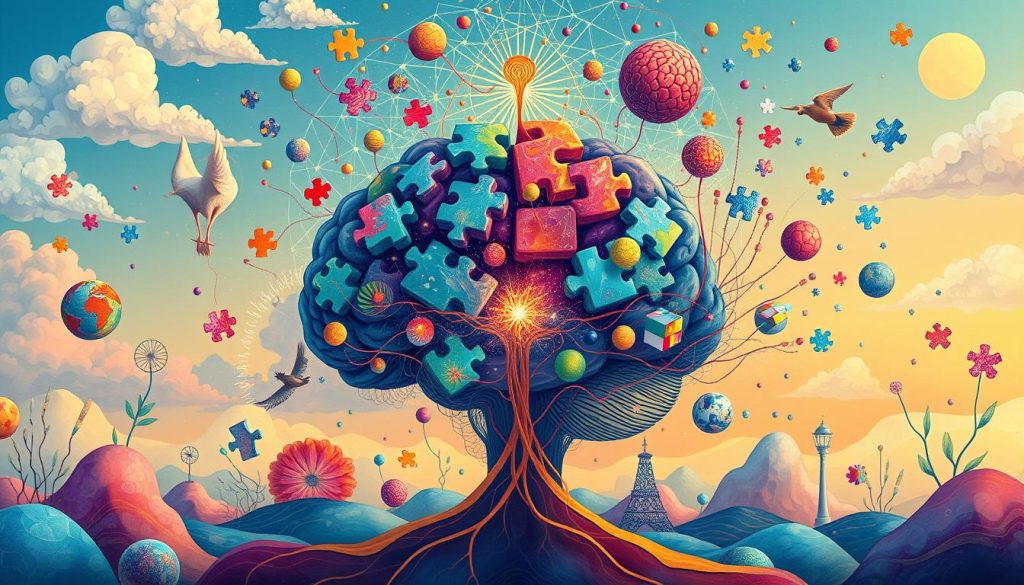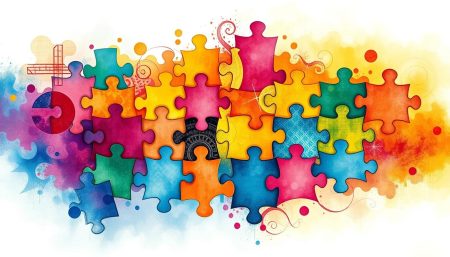Understanding autism spectrum disorder symptoms in adults is key. These signs are often missed, but they need our attention. This guide is for those who think they might have autism, their families, and healthcare workers.
The term ‘autism spectrum disorder’ (ASD) is known today. Yet, spotting autism in adults is hard. It’s because adult ASD symptoms are complex. We aim to make diagnosis and support clearer for adults with autism.
We’re on a mission to learn more about autism in adults. We want to understand the signs and what it’s like to live with autism. It’s about growing our empathy and valuing the unique views of those on the spectrum.
Understanding Adult Autism Spectrum Disorder
Recognizing autism in adults is key. Unlike kids, grown-ups often show subtle signs that can be hard to spot. This part explains the basics of adult autism symptoms and how they differ from childhood signs.
The Basics of Autism Spectrum Disorder in Adults
Adult autism covers a wide range of symptoms. It includes trouble with social skills, repetitive actions, and communication. Many adults are diagnosed later in life, making it a complex process.
Signs include trouble understanding social cues, managing sensory issues, and sticking to routines. If these routines are broken, it can cause a lot of stress.
Differences Between Childhood and Adult ASD
Autism symptoms can change from childhood to adulthood. Adults may hide their symptoms by adapting to their daily lives. This makes diagnosing adult autism different from diagnosing children.
Adults might use clever ways to hide their challenges. This makes it harder to spot the signs and impacts how diagnosis is done.
| Key Element | Childhood Diagnosis | Adult Diagnosis |
|---|---|---|
| Social Interactions | Clear difficulties in making friends, sharing interests | Subtle issues in reading social cues, maintaining relationships |
| Behavioral Signs | Evident repetitive behaviors | Structured routines, less noticeable repetitive patterns |
| Communication Challenges | Delay in language skills, literal use of language | Subtle nuances missed in complex conversations, use of learned phrases to compensate |
Early Indicators of Autism in Adults
Spotting early adult autism symptoms is key to helping those with autism spectrum disorder (ASD). Every person with autism is different, but some signs can hint at ASD from a young age. This part looks at important signs of autism in adults and why they matter.
Signs of autism in adults might not show up in childhood. But looking back, early signs often appear. Spotting these signs early can lead to better support and outcomes. Adults who notice these signs may better understand their social and sensory experiences.
- Intense interests or hobbies that are narrowly focused and sometimes obsessive
- Difficulties in maintaining typical social interactions, which may have been evident as challenges with peer interactions in their youth
- Distinct preference for predictable routines and environments, with marked distress during unexpected changes
- Heightened or reduced sensitivity to sensory stimuli, like sounds, lights, or textures, that persist into adulthood
These behaviors are important signs for adults looking back or for those noticing signs of autism in adults. Spotting them can lead to a deeper look and possibly a diagnosis. This first step is key to improving life quality.
| Early Sign | Description | Impact in Adulthood |
|---|---|---|
| Intense Interests | Engagement in specific topics or activities at an intensity or duration not typical of their peers. | May lead to specialized skills or careers but can isolate from broader social interactions. |
| Social Interaction Difficulties | Challenges with understanding social cues and maintaining friendships. | Can result in social anxiety or misunderstanding in work and personal relationships. |
| Need for Routine | Strong preference for structured environments and resistance to unexpected changes. | Provides comfort and security but may struggle with flexibility required in daily life. |
| Sensory Sensitivity | Over or under-reaction to physical stimuli in the environment, such as noise or tactile sensations. | Affects personal and professional environment choices, possibly leading to avoidance behaviors. |
Understanding early adult autism symptoms and their lasting effects is vital for recognizing and supporting adults with autism. Each sign, when seen together, offers deep insights into adult ASD.
Common Challenges Faced by Autistic Adults
Adults with autism face unique challenges that affect their daily lives. These challenges include trouble with social interactions and handling too much sensory input. It’s important to understand and tackle these issues to improve their quality of life.
Navigating Social Integration
Adults with autism find social interactions hard. They struggle to read social cues and keep up in conversations. This makes it tough for them to feel accepted in social settings.
Training in social skills and using peer support can help. These methods aid autistic adults in their social interactions.
Coping with Sensory Overload
Many autistic adults are very sensitive to sensory inputs. This can include background noise or the feel of clothes. This sensitivity can cause anxiety and discomfort, making everyday tasks hard.
Creating environments with less sensory input helps manage these symptoms. Mindfulness and sensory integration therapy can also offer relief and improve daily life.
An autism spectrum disorder symptoms checklist is useful. It helps identify challenges and create a plan to manage them. This checklist tracks changes in sensitivity and social skills, guiding support efforts.
| Challenge | Description | Recommended Strategies |
|---|---|---|
| Social Integration | Difficulty in understanding social cues and engaging in prolonged conversations. | Peer-mediated approaches, social skills training. |
| Sensory Overload | Increased sensitivity to environmental stimuli leading to anxiety and discomfort. | Environment modifications, sensory integration techniques, mindfulness. |
Using tailored strategies from the autism spectrum disorder symptoms checklist can greatly improve life for autistic adults. The key is to keep practicing and adapting, both socially and in personal environments.
Recognizing Autism in Adults: Behavioral Signs
Spotting autism in adults can be tricky because the signs are often subtle. This part talks about the behaviors that might show someone has autism spectrum disorder (ASD). It helps both readers and doctors understand and spot autism in adults better.
One key sign is repetitive actions. These can be simple or complex routines that someone feels they must do. These actions help them deal with uncertainty or stress.
- Strict adherence to routines and schedules
- Repetitive body movements, such as hand-flapping or rocking
- Intense preoccupation with specific topics or objects
It’s important to understand these behaviors to recognize autism in adults. They can greatly affect how someone lives and their relationships. These signs might not be obvious to others, so knowing about them is key for support.
These behaviors can deeply affect an adult’s life. They might find social interactions hard because of trouble understanding social cues or focusing too much on certain interests. This can cause them to feel isolated or struggle at work.
Knowing about these signs helps friends, family, and coworkers be more supportive. This understanding makes places more welcoming for everyone, at home and at work.
Seeing these behaviors in a kind light helps reduce stigma. It makes life better for adults with autism. Recognizing them is the first step to helping and including them more in our lives.
Autism Spectrum Disorder Symptoms in Adults
It’s important to understand autism spectrum disorder symptoms in adults. This helps with better support and self-awareness. We’ll look at key aspects like communication issues and rigid routines, common in adults with ASD.
Communication Difficulties in Adult ASD
Adults with ASD face big challenges in talking and understanding non-verbal cues. They might struggle with gestures, facial expressions, and social signals. Also, having conversations can be hard because they find it tough to pick up on emotions and subtle speech.
These problems can cause misunderstandings and lead to feeling left out. It’s a big part of why adults with ASD might feel isolated.
Rigid Routines and Resistance to Change
Adults with ASD often prefer set routines and environments. Any sudden changes can make them very anxious. They might stick to their routines closely to manage their lives, and any changes can upset them a lot.
Let’s compare typical adult ASD symptoms with those of neurotypical adults:
| Aspect | Adults with ASD | Neurotypical Adults |
|---|---|---|
| Communication | Difficulty with non-verbal cues, prefers direct and literal speech. | Uses and understands subtle and indirect forms of communication. |
| Response to Change | Highly resistant, prefers strict routines. | More adaptable, can handle spontaneous changes. |
| Social Interaction | Limited interest in social engagements, finds groups challenging. | Often enjoys socializing, comfortable in groups. |
The chart above shows the main differences in daily life for adults with ASD. It highlights the unique challenges they face. By understanding these differences, we can create better support systems to improve their lives.
Physical Symptoms Often Overlooked in Adult ASD
Autism spectrum disorder (ASD) is often seen as just a mental condition. But, physical symptoms are also important and often missed. It’s key to understand these adult autism symptoms for a complete diagnosis and treatment.
People with ASD might face physical challenges like coordination problems and unusual walking. They can also have stomach issues that make everyday life hard.
Studies link ASD to physical health problems. For example, many adults with ASD struggle with motor skills. This can show as clumsiness or hard-to-coordinate movements. Also, stomach problems are common in ASD, but often not seen in adult diagnoses.
Understanding autism’s neurodevelopmental aspects is important.
| Physical Symptom | Common in ASD | Impact on Lifestyle |
|---|---|---|
| Motor Coordination Issues | Yes | Difficulty with physical tasks, sports, and some types of employment |
| Unusual Gait | Often | May affect mobility, endurance, and social perceptions |
| Gastrointestinal Problems | Frequently reported | Can lead to discomfort, dietary restrictions, and anxiety about social eating situations |
Dealing with adult autism symptoms means recognizing and addressing them. This knowledge helps in creating better healthcare plans. By acknowledging all signs of autism in adults, including physical ones, we can improve their lives.
Adult Autism Symptoms: Emotional Regulation and Response
Understanding autism spectrum disorder signs in grown-ups shows us how emotions can vary a lot. Adults with ASD often handle emotions differently than others. This is important to know when looking at ASD symptoms in adults.
The Emotional Spectrum in Adult Autism
Adults with autism may feel emotions in a special way. This makes social interactions tricky. Some might react strongly to small things, while others seem less emotional.
It’s important to understand these differences. This helps us see the full range of emotional ASD symptoms in adults.
Interpreting Emotional Responses
People with ASD might show emotions in ways that are hard to understand. This can lead to misunderstandings in relationships and at work. It’s key for everyone to get these differences better.
This way, we can improve communication and support. It makes life better for adults with autism.
- Intense emotional responses to minor changes
- Challenges in expressing feelings appropriately
- Difficulty in understanding others’ emotions
Knowing these signs and supporting emotional needs can greatly improve life for adults with autism. It helps them do better in personal and work life. Understanding these autism spectrum disorder signs in grown-ups is essential for the right support.
Roles of Repetitive Behaviors in Adult Autism Symptoms
Repetitive behaviors are key in autism spectrum disorder, important for spotting autism in adults. These actions, from simple movements to complex rituals, offer comfort and stability. Yet, they can also pose daily challenges. It’s vital to grasp these behaviors to fully understand adult ASD symptoms.
There are different types of repetitive behaviors in autism, each with its own purpose. They help manage anxiety and provide a structured way to navigate the world. This is not always clear to others.
- Simple Motor Movements: Activities like hand-flapping, rocking, or head-nodding. They help regulate sensory input in busy environments.
- Ritualistic Behaviors: Sequences like arranging objects in a specific order. Changes can cause distress, showing their importance for predictability and control.
- Verbal Repetition: Echoing phrases or words, known as echolalia. It’s a common verbal behavior in adults with ASD.
These repetitive behaviors are vital for adults with autism to feel balanced. Yet, they can hinder daily tasks and social interactions. Recognizing and understanding these behaviors helps create more supportive environments.
Therapy and support can be tailored to lessen the impact of these behaviors. It’s about finding ways to cope without causing more stress. Behavioral therapies aim to introduce new strategies to replace or reduce repetitive actions.
Recognizing autism in adults means seeing the value in these repetitive behaviors. They are often misunderstood or ignored. Acknowledging them leads to better support and accommodations, helping individuals with ASD thrive in various life areas.
Relationships and Autism: Adult Perspectives
Autism Spectrum Disorder (ASD) impacts many areas of life, including personal and work relationships. Knowing how adult autism shows in social interactions helps in diagnosing and building better connections. This is true for colleagues, friends, and partners.
Friendships and Dating with Adult Autism
Adults with autism face unique challenges in friendships and dating. Social cues that come naturally to others might not be clear to them. This can cause misunderstandings or make them feel anxious.
It’s key for both sides to be patient and talk openly. This helps in understanding each other better.
- Clarity in Communication: Straightforward and clear talk helps avoid confusion.
- Consistency and Routine: Stability is comforting, making regular plans good.
- Mutual Interests: Sharing common hobbies can spark conversations and connections.
Autism’s Impact on Workplace Interactions
In the workplace, autism can change how someone interacts with colleagues and bosses. Recognizing these signs helps in diagnosing and making the workplace more inclusive. This benefits everyone.
| Challenge | Strategy |
|---|---|
| Misinterpretation of social cues | Promote an open-dialogue culture where questions are encouraged |
| Difficulty with unstructured socializing | Structured social events with clear agendas |
| Sensitivity to office noise | Provision of noise-canceling headphones or quiet work areas |
By understanding and meeting the needs of ASD, employers can make a more welcoming space. This space values and uses the unique strengths of all employees, including those with autism.
Cognitive Abilities and Strengths in Adult ASD
When we talk about ASD symptoms in adults, we often focus on the challenges. But it’s important to also talk about the strengths and cognitive abilities many have. These talents can make a big difference in many areas, showing how valuable adults with ASD can be.
Adults on the autism spectrum often have a great skill in pattern recognition. This helps them solve problems and analyze things better. Their attention to detail is also top-notch, making them perfect for jobs that need precision, like data analysis and engineering.
They can also focus intensely on things they’re interested in. This can make them experts in certain subjects or jobs. By using these strengths, not only do individuals with ASD benefit, but they also bring new ideas and solutions to work.

It’s key to recognize these cognitive abilities to help autistic adults succeed. For more info on neurodevelopmental conditions and how they affect daily life, check out this ADHD overview. It helps understand the diversity of the human brain.
| Cognitive Skill | Benefits | Applicable Fields |
|---|---|---|
| Pattern Recognition | Enhances analytical abilities | Data Analysis, Academic Research |
| Attention to Detail | Increase in quality and accuracy of work | Software Development, Quality Assurance |
| Intensive Focus | Ability to develop deep expertise | Specialist roles in IT, Science, Arts |
By recognizing and promoting the unique skills of autism spectrum disorder symptoms, we can better support adults with ASD. This way, they can share their special talents and views with the world.
Signs of Autism in Adults: The Subtleties
Spotting the subtle signs of autism in adults can change lives. It helps with diagnosis and understanding adult autism symptoms better. These signs often show up as special ways people feel things and what they like.
Sensory Sensitivities and Personal Preferences
Adults with autism might feel things more or less than others. This could be how they react to touch, sound, taste, or sight. Knowing these signs can help us interact better with them.
Deconstructing the Myth of ‘Normal’ Behavior
The idea of ‘normal’ behavior can hide signs of autism in adults. By questioning this idea, we move towards a world that values all kinds of brains. We see differences as part of what makes us unique, not wrong.
Looking into these details needs careful watching and openness. We must be ready to see and accept the wide range of behaviors and likes that show autism in adults.
| Sensory Element | Common Reaction | Implication for Adults with Autism |
|---|---|---|
| Textures | Preference for certain fabrics or aversion to others | Indicator of sensory sensitivity |
| Sounds | Overwhelmed by loud noises or fascinated by specific sounds | Can signal hyper- or hypo-sensitivity |
| Visual Stimuli | Discomfort with bright lights or intense interest in detailed patterns | Potential sign of adult autism |
| Tastes | Restricted eating habits or strong preferences/dislikes | May relate to sensory sensitivities |
Diagnosing Autism in Adults: The Process Explained
Understanding the journey to diagnosing autism in adults is key for those who think they might be on the autism spectrum. This part explains how to get an adult autism diagnosis. It highlights the need for a detailed check-up by healthcare experts.
Criteria for Adult ASD Diagnosis
To get a diagnosis of autism spectrum disorder in adults, certain criteria must be met. These criteria are found in diagnostic tools. They help spot the unique symptoms that show up in adulthood, which are different from those seen in children.
- Persistent difficulties in social communication and social interaction across multiple contexts
- Restricted, repetitive patterns of behavior, interests, or activities
- Symptoms must be present in the early developmental period (though they may not fully manifest until social demands exceed limited capacities)
- Symptoms cause clinically significant impairment in social, occupational, or other important areas of current functioning
The evaluation looks at the person’s developmental history. It also includes observations and specific assessments for adults.
Seeking Professional Help for a Diagnosis
For diagnosing autism in adults, it’s vital to talk to healthcare experts who focus on adult autism. This usually means seeing psychologists, psychiatrists, and neurologists with autism experience. Getting a diagnosis involves a team effort for a full evaluation.
- Initial screening using an autism spectrum disorder symptoms checklist
- Developmental history interviews, often with input from family members
- Behavioral assessment through direct observation
- Neurological and psychological testing, if applicable
Though it might seem tough, knowing and meeting each criterion is vital for a correct diagnosis. This opens the door to support and help tailored just for you.
Adult Autism Symptoms Checklist: A Self-Assessment Tool
It’s hard to spot autism in adults because the signs are not as clear as in kids. This section offers a self-checklist to help identify autism symptoms in adults. Remember, this is just a starting point for those thinking about getting a professional check-up.
This checklist lists behaviors and traits seen in adults who might have autism. While only a doctor can give a real diagnosis, this tool can help you see if your experiences match common autism symptoms in adults.
| Checklist Item | Description |
|---|---|
| Preference for Routine | Feeling stressed or anxious when routines change. |
| Social Communication Challenges | Having trouble understanding and responding to social cues; might take longer to process what’s said. |
| Over- or Under-Sensitivity to Sensory Input | Reacting badly to certain sounds, tastes, smells, or textures that others might not notice. |
| Need for Alone Time | Wanting to be alone more, often after being around people or in loud places. |
| Fixed Interests | Being very interested in specific topics, leading to a deep knowledge in those areas. |
Note: If many items on this checklist sound like you, it’s a good idea to get checked by a professional who specializes in autism in adults. Spotting autism early can help you get the support and strategies you need to live better.
Adult ASD Symptoms: The Invisible Struggle
Adult ASD symptoms are harder to spot than in children. This makes it tough to recognize autism in adults. We’ll look at the hidden struggles and other health issues that affect daily life.
Understanding Co-occurring Conditions
Adults with ASD often face mental health problems like anxiety, depression, or ADHD. These issues can make it harder to spot and treat autism. It’s because these symptoms can hide or mix with autism signs, needing a detailed diagnosis.
- Anxiety can make sensory issues worse for those with autism.
- Depression can lead to more social withdrawal in autistic adults.
- ADHD can worsen problems with focus and organization in autistic adults.
Strategies for Management and Support
Handling adult ASD symptoms needs a complete approach. It must consider all aspects of a person’s life, including mental health. This might include therapy, medicine, lifestyle changes, and support to help with everyday life.
- Therapeutic Support: CBT and other therapies can help with anxiety and depression linked to autism.
- Medications: Sometimes, medicine is used to manage specific symptoms or improve mental health.
- Lifestyle Modifications: Regular exercise, healthy eating, and enough sleep can boost emotional and physical health.
- Community and Social Support: Support groups and community resources provide vital social support and understanding, helping to fight loneliness.
Spotting autism in adults and related conditions needs careful attention and understanding. Each person’s journey is unique. Tailored plans are key to helping adults with ASD live well and manage their symptoms.
Autism Spectrum Disorder Signs in Grown-ups: Beyond Stereotypes
Understanding autism spectrum disorder signs in grown-ups means moving past common stereotypes. The signs of autism spectrum disorder symptoms in adults vary widely. This shows we need to tailor our approach to each person.
It’s important to see the wide range of experiences adults with autism have every day. We want to show how different these signs can be. And why it’s key to value this diversity.
- Cognitive differences that may not align with traditional expectations of autism
- Subtle social nuances that defy the typical autism diagnosis
- An array of strengths in fields such as art, engineering, and technology
- Unique coping mechanisms that enable managing daily stressors
This complexity shows up in both public and personal life. It challenges the idea that autism in adults is the same for everyone.
| Aspect | Common Stereotype | Actual Diverse Sign |
|---|---|---|
| Social Interaction | Poor social skills across all settings | Varied social skills, often context-dependent |
| Communication | Limited vocal expression | Diverse communicative abilities, including nonverbal genius |
| Behavior Patterns | Inflexibility and rigidity | Flexible behaviors in familiar environments |
| Interests | Narrow, obsessive focus on specific topics | Broad, deep interest in multiple areas |
By broadening our understanding and moving past old stereotypes, we can better support autism spectrum disorder symptoms in adults. Remember, each person’s experience is unique. Broad definitions are just the beginning for deeper understanding.
Living with Autism: Adult Stories and Experiences
Exploring the lives of adults with autism reveals a rich tapestry of experiences. They face challenges in social interactions but also find their strengths. These stories show how adults with autism adapt and discover their place in the world.
These personal tales often highlight the need for understanding and acceptance. They share the hidden struggles and celebrate the victories. These stories help break down myths and show the real lives of those with autism.
These stories offer hope and connection to others on the autism spectrum. They show that living with autism is not just about the diagnosis. It’s about thriving with a unique view of the world. These experiences enrich our understanding of autism and adult life.
FAQ
Q: What is autism spectrum disorder in adults?
A: Autism spectrum disorder (ASD) in adults is a range of conditions. They include challenges with social skills and repetitive behaviors. Adults with ASD also have unique strengths and differences.
Diagnosing ASD in adults can be complex. This is because they may have developed coping strategies. Symptoms can also vary.
Q: How does autism spectrum disorder differ between adults and children?
A: Adults with ASD may hide their symptoms with strategies. This makes it less obvious than in children. Responsibilities and other conditions also affect how symptoms are seen in adults.
Q: What are some early indicators of autism in adults?
A: Early signs include trouble making friends and intense interests. Sensory sensitivities and managing social situations are also indicators. These signs often start in childhood or adolescence.
Q: What challenges do autistic adults often face?
A: Autistic adults often struggle with social integration. They may experience sensory overload and communication difficulties. Strict routines can also impact their life.
Q: What behavioral signs can help in recognizing autism in adults?
A: Behavioral signs include repetitive actions and strong preferences for sameness. Adults with ASD also have intense interests and social interaction challenges.
Q: Can autism in adults present physical symptoms?
A: Yes, adults with ASD may have physical symptoms. These include motor coordination issues and unusual posture. Gastrointestinal problems are also common but often overlooked.
Q: How do adults with autism regulate and respond to emotions?
A: Adults with autism may have a different emotional spectrum. They might struggle with emotional regulation. They can also react intensely to changes or struggle to express their feelings.
Q: What role do repetitive behaviors play in adult autism?
A: Repetitive behaviors provide comfort and structure for adults with autism. But, they can also interfere with daily life. Others may not understand these behaviors.
Q: How does autism affect relationships and work interactions in adults?
A: Autistic adults may find it hard to form and keep relationships. This includes friendships and romantic relationships. At work, they may struggle with social cues and teamwork.
Q: What are the cognitive strengths often found in adults with ASD?
A: Adults with ASD often have exceptional attention to detail. They also have superior pattern recognition and intense focus on interests.
Q: What are subtle signs of autism in adults that might go unnoticed?
A: Subtle signs include less obvious sensory preferences or aversions. Adults with ASD may also follow personal routines that seem eccentric. Their social communication can be nuanced and not typical.
Q: What is involved in the process of diagnosing autism in adults?
A: Diagnosing autism in adults involves a detailed evaluation by healthcare professionals. This includes looking at developmental history and observing behavior. It also involves checking against ASD diagnostic criteria.
This process may include interviews, questionnaires, and referrals for further assessments.
Q: How can an adult ASD symptoms checklist help in recognizing the condition?
A: An adult ASD symptoms checklist can help identify behaviors and patterns. It prompts individuals to seek professional evaluation for a formal diagnosis.
Q: What invisible struggles might adults with ASD face?
A: Adults with ASD may face internalized challenges like anxiety and depression. These mental health issues are not always visible to others. Recognizing and addressing these is key for support.
Q: How can society move beyond stereotypes associated with adult autism?
A: Understanding the diversity of ASD experiences among adults is important. This helps move beyond stereotypes. It recognizes the individuality of each person with autism.
Q: Why is sharing personal stories and experiences of adults with autism important?
A: Sharing personal stories humanizes autism, fostering empathy and understanding. It provides real-life context to symptoms discussed in guides. It also helps others with similar experiences feel less alone.


















